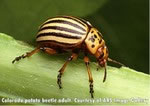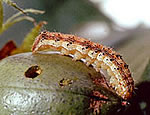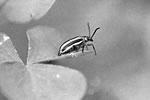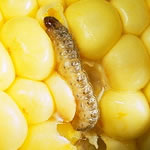Carrot Rust Flies

Another fan of carrots, these seven millimeter, slender redheaded flies can also be a problem. They lay their eggs in the soil near carrot plants. When they hatch the white larvae, the maggots that they are, feed on the carrot’s root hairs and the prized tap root. They cause physical damage and allow root rots to flourish. Row covers will protect carrot plants from egg-laying adult flies — assuming, that is, that they emerged from somewhere other than from under the row cover. Parasitic Nematodes will kill the larvae, so they are, once again, an option. Capsicum wax and garlic sprays may deter the adult flies.
Carrot Weevils
Are carrots on the menu tonight or what? Here’s another bug which loves carrots. These six millimeter brown weevils do the same thing as the other carrot pests mentioned previously: they lay eggs, the immature stages eat. And the same controls will apply, too. Parasitic Nematodes, row covers, plastic sheeting, etc.
Chafers
European, masked, rose and other chafers are pests many people are familiar with. Collectively, they are beetles of a particular family. And like most pestiferous beetles, they are damaging to plants in their adult and larval forms. Chafers feed on many different types of plants. The particular size and appearance of these beetles, and their subsequent diet, depends chiefly on which type of chafer you’re dealing with. The grubs or larvae are quite similar to the casual observer: they’re C-shaped whitish grubs. Their presence can also lead a mole invasion which, in its own right, can devastate a lawn or garden. (The best way to get rid of moles is to destroy their source of food: the grubs.) Like the other beetles, chafers are more readily controlled in their larval form as the adults are mostly vulnerable only to harsher chemicals. The adults can be picked off of plants by hand. Moreover, the plants can be protected by covering them with a floating row cover. But using Parasitic Nematodes will yield far better results. Additional control may be obtained from azadirachtin, the active ingredient in neem-based products.
Chinch Bugs

The black and white narrow shield-shaped true bugs may be seen weaving their way through your lawn’s thatch. These bugs may be covered with a white powdery bloom and can grow to six millimeters in length. They attack certain grasses which lack endophytes and can cause yellow patches and areas of dieback. Probably making the most sense is to forgo susceptible grasses and to plant one containing endophytes. Your seedsman will know this information. “Endophytic,– may even be printed on the bag. This makes the most sense because other forms of control are generally too impractical.
Colorado Potato Beetles

These one centimeter and larger yellow and black striped beetles are widely known-especially in potato country (even though they are known to feed on other crops such as tomatoes). The adults and their orange larvae are big feeders and can cause tremendous damage in the form of ragged holes to complete defoliation. In some circles these beetles are considered major pests. Fortunately there are decent controls available. The most popular control are the Spinosad products.
As far as biological pest controls agents, some say ladybugs feed on the eggs of these beetles. On the other hand, spined soldier bugs, Podisus maculiventris, do prey on the larvae. And since they are now commercially available, are a biologically viable means of subduing these pests.
Corn Earworms

The larvae of these moths can be very damaging to corn plants. Corn earworm moths make lengthy annual northerly migrations which, if monitored, can provide growers with a warning. Unfortunately, aside from toxic sprays, there is nothing that we know of which will prevent the moths from arriving and laying eggs. There are controls for the larvae, though. The pale tan and dark striped larvae, which grow five centimeters, consume corn silks, then follow those silks into the husks, ultimately munching on the ear of corn’s kernels. Much of the damage is cosmetic and can be cut away, but consumers can be picky and will often refuse to buy affected corn. Moreover, the larvae expel visible fecal matter as they feed and move, making their presence even more obvious. To control these pests, Bacillus thuringiensis (K) (Bt) variety Kurstaki, can offer limited control. Parasitic Nematodes can also parasitize these pests if injected between the husk and the ear, but this method of control would not be an option in all but the smallest and earliest of outbreaks-it’s not realistically a viable solution.
Cucumber Beetles

These one centimeter beetles come in two forms: one is yellow with black stripes; the other is yellow with black spots. They are known as striped- and spotted-cucumber beetles, respectively. Unlike many beetles, their larval forms are found on the foliage portions of plants. Their larvae, therefore, which can be impacted with spined soldier bugs, Podisus maculiventris, cannot be thwarted by Parasitic Nematodes. Their pupae, though, which do use the soil as their protected development grounds, can. The larvae and adults munch on the leaves of many plants causing ragged feeding holes.
Curculios

These grayish, black one centimeter beetles are top candidates for the World’s Ugliest Bug Award. And the damage they cause to fruits such as plums and apples isn’t any prettier. The adults feed on leaves, buds and flower petals, sometimes cause fruit deformities. They then lay their eggs in crescent-shaped wounds-which they make with their pointed, weevilish mouthparts, in any fruit which does develop, and the resulting larvae feed from within. The larvae cause the fruit to rot on the stem, develop grotesque deformities, and sometimes drop to the ground. Curculios are one of those pests which seem to defy the use of non-chemical controls. What may help is the use of repellent products such as garlic or capsicum pepper-based products or, perhaps, neem-based formulations.
Cutworms

Previously discussed in the Soil Pests page, these pests warrant a second mention here. Cutworms are the large (up to five centimeters) larvae of several species of moths. They live near the base of plants they’ll consume as they grow up — storing energy for pupation. Cutworms come to the soil’s surface at night, wrap themselves around the stem of their target plants — which are usually a new, tender — stemmed seedlings — and proceed to girdle them. Gardeners often find cutworm damage the morning after the pests’ feeding binge in the form of plants lying on their sides. Some control can be obtained from azadirachtin, the active ingredient in neem-based products. Parasitic Nematodes, are an excellent way to control these pests.
European Corn Borers

As their name implies, these are mostly pests of corn. The pestiferous stage of these moths is as larvae. The adults lay eggs on the plants and the resultant tan larvae, which can grow to 3 cm., burrow in the ears and stems expelling frass as they go. The stem feeding may cause plants to collapse; the ear feeding causes unsightly damage to the ears. Realistically the damaged portions can be cut away without ill-effect. But many people, being what they are, find the damage unacceptable are not willing to pay for tainted corn. Fortunately there are controls for these pests which work. Bacillus thuringiensis (K) (Bt) variety Kurstaki in a granular form, if applied appropriately, can effectively control these pests. If coupled with the use of moth-egg parasitoids such as Trichogramma brassicae, and performing a proper cleanup and disposal of affected plants at year’s end, control can be easily obtainable. Additional control can be obtained from azadirachtin, the active ingredient in neem-based products. Parasitic Nematodes can also parasitize these pests if injected in the bored holes, but this method of control would not be an option in all but the smallest and earliest outbreaks — it’s not realistically viable.
